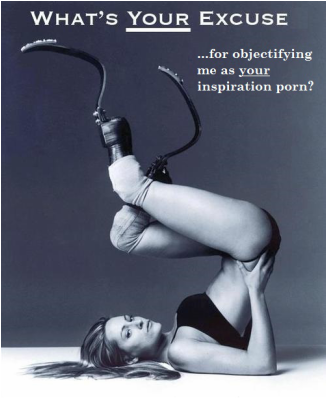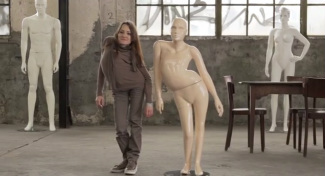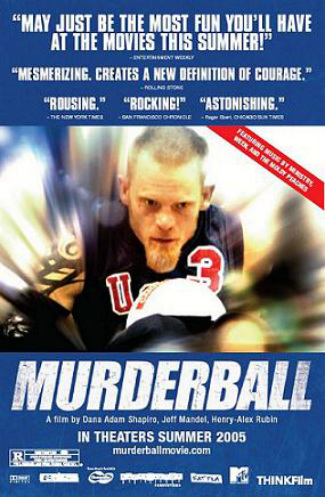 "What's your excuse...for objectifying me as your inspiration porn?" Amy Purdy poses while wearing her running blades "What's your excuse...for objectifying me as your inspiration porn?" Amy Purdy poses while wearing her running blades Tags: bodies, culture, disability, emotion/desire, inequality, knowledge, marketing/brands, media, sports, inspiration porn, super bowl, 00 to 05 mins Year: 2015 Length: 1:15 Access: YouTube Summary: Every year the Super Bowl proves to be a rich site for sociological investigation, and we have analyzed many different aspects of this American spectacle, including the commercials. All media, but the commercials of the Super Bowl in particular, can be seen as cultural artifacts. Ads are saturated with resonant images and meanings, and with a little work, one can deduce information about the society that created the ads, how they see themselves and what they believe about the world. The commercials of Super Bowl XLIX featured a surprising number of people with disabilities. Among them, Reebok and Toyota showcased athletes with prosthetic legs engaged in rather punishing exercise regiments. Our video of the week is the Toyota ad, which tracks world-class snowboarder and double amputee, Amy Purdy, on the slopes, in a dance hall, and as the subject of a photo shoot. Microsoft's ad, by contrast, centered on Braylon O'Neil, a toddler learning how to walk and play T-Ball with his prosthetic legs. All of the ads were accompanied by narration that attempted to inspire and somehow leave audiences with the impression that Microsoft, Toyota, or Reebok are central players in helping humanity realize its full potential. • The problem is that the ads reek of what is sometimes referred to as inspiration porn. That is, to the extent that people with disabilities feature in media at all, they are typically portrayed in a very one-dimensional way; as a narrative device that has been fashioned with the sole intent of inspiring the able-bodied majority. For those who think inspiration porn isn't a big deal, consider the awkward similarities it shares with the old practice of featuring people with disabilities as freaks in circus sideshows. Toyota is using Amy Purdy to inspire the able-bodied majority, whereas P. T. Barnum used double amputees to amuse. In both cases, people with disabilities are being objectified to give the majority a big emotional experience. Find more information and resources about disability and media representation on our Pinterest board. Submitted By: Lester Andrist
6 Comments
 Mannequins are rebuilt in this Pro Infirmis video on disability Mannequins are rebuilt in this Pro Infirmis video on disability Tags: art/music, bodies, consumption/consumerism, culture, disability, discourse/language, inequality, knowledge, disability porn, stereotypes, subtitles/CC, 00 to 05 mins Year: 2013 Length: 4:29 Access: YouTube Summary: In this four minute video from the Swiss company Pro Infirmis, five people with visible disabilities arrive at an artist's studio. After introductions, the artist begins measuring the dimensions of each person's body. His team then begins sawing into a collection of store mannequins, and once dismembered, the mannequins are reconstructed so they more closely resemble the body designs of the artist's new models. After some polish, the new mannequins are unveiled and eventually displayed in stores along one of Zurich's main streets, just in time for the International Day of Persons with Disabilities. The project's title is a rhetorical question and a command, "Because Who Is Perfect? Get Closer." Indeed, no one is perfectly able-bodied. Whether visible or invisible, on some level it is true that all bodies can be said to have "malfunctions," but the deeper reason no one is perfect is because the idea of what constitutes perfection is itself elusive. Yet, most people go about their daily lives seduced by the illusion that distinguishing "able-bodied" people from "disabled" people is as straightforward as distinguishing apples from oranges. For instance, there is a Thor fandom that celebrates Chris Hemsworth's shirtless body as the epitome of perfection. Mall shoppers too routinely evaluate clothing for themselves and others by first seeing it draped over what is supposed to be a mold of a perfect body. Capitalist institutions, from the Hollywood film industry to clothing retailers, routinely place the able-bodied ideal on a pedestal, implicitly exalting a particular type of body as the standard by which all bodies must be evaluated, and it is on this point that the Pro Infirmis video is both refreshing and subversive, for it takes what are assumed to be imperfect bodies and places them in a space typically reserved for perfect bodies. These new mannequins of unfamiliar proportions stop passersby in their tracks and encourage them to reconsider the types of bodies that belong in storefronts, but while the video captures a useful disruption in the usual discourse on bodies, in my view it fails to truly provoke onlookers to reassess their casual assumptions about bodies as either working or broken, and as either worthy or unworthy of representation. No, the video leaves this binary cultural logic unscathed. For instance, one finds in the video that "able-bodied" mannequins are the clean slate from which "disabled" mannequins are born. There is a manufacturing montage that puts to rest any radical doubts as to whether these two species of mannequin have anything in common. Finally, when displayed in the Zurich storefronts, the altered mannequins remain almost hermetically sealed from the original mannequins, which have been scuttled away for the event. To truly "get closer," as the video commands us to do, I think it is important to collapse this casual, Manichean distinction between the able-bodied and the disabled. A truly radical video might instead show the old mannequins displayed alongside the new ones, and the displays would be left in place long after the International Day of Persons with Disabilities was over. Submitted By: Lester Andrist  Eugenic thinking is woven into the fabric of American society Eugenic thinking is woven into the fabric of American society Tags: biology, bodies, class, crime/law/deviance, demography/population, disability, discourse/language, gender, health/medicine, immigration/citizenship, intersectionality, lgbtq, nationalism, prejudice/discrimination, race/ethnicity, science/technology, sex/sexuality, institutionalized discrimination, eugenics, subtitles/CC, 11 to 20 mins, 21 to 60 mins Year: 2012; 2013 Length: 15:05; 17:25 Access: YouTube (clip 1; clip 2) Summary: The eugenics movement has a long history in the United States. A popular misconception is that eugenic thinking and the associated practices were uniformly abandoned after the Third Reich's genocidal intentions were laid bare at the end of the Second World War. In point of fact, eugenic ideologies and practices have been recalcitrant features of American social institutions right up until the present day. In her book American Eugenics: Race, Queer Anatomy, and the Science of Nationalism, Nancy Ordover remarks on the resiliency of the ideology, "Eugenics..is a scavenger ideology, exploiting and reinforcing anxieties over race, gender, sexuality, and class and bringing them into the service of nationalism, white supremacy, and heterosexism." In earlier decades eugenicists could openly discuss stemming the "overflow" of immigration, as an effort to "dry up...the streams that feed the torrent of defective and degenerate protoplasm." The language of eugenics would eventually change, but the core ideas have remained; socially deviant groups and socially undesirable conditions are seen by eugenicists as biologically determined. The above clips are news stories, which draw attention to two recent manifestations of eugenics policy. The first clip chronicles the experience of an African American woman who was legally sterilized in the late 1960s in North Carolina after giving birth to her first son. The clip reports that between 1929 and 1974 approximately 7,600 North Carolinians were sterilized for a host of dubious reasons, from "feeble-mindedness" to "promiscuity." But while North Carolina's victims included men, women, and children, Ordover's research points out that the victims were overwhelmingly women and African American (by 1964 African Americans composed 65% of all women sterilized in the state). The first clip, then, is an example of how eugenics became institutionalized with the force of law, but the second news clip examines a case of institutionalized eugenics in California, which existed without the explicit consent of law. In 1909 California became the third state to pass a compulsory sterilization law, allowing prisons and other institutions to sterilize "moral degenerates" and "sexual perverts showing hereditary degeneracy." By 1979, when the law was finally repealed, the state had already sterilized as many as 20,000 people, or about one-third of the total number of such victims throughout the United States. One learns from the news clip that between 2006 and 2010, 148 women were sterilized by doctors who continued to be guided by the precepts of their eugenic ideology. Submitted By: Lester Andrist  _Tags: bodies, disability, health/medicine, inequality, prejudice/discrimination, stereotypes, subtitles/CC, 06 to 10 mins Year: 2007 Length: 10:47 Access: YouTube (part 1; part 2) Summary: What if ablebodied people were a minority? What would navigating that world be like? This film put out by the Disability Rights Commission (UK) turns the tables on a world that favors the ablebodied, and invites viewers to imagine what it would feel like if they found themselves subjected to the difficulties, discomforts, humiliations, and discrimination that disabled people face on a regular basis. This is a useful way to open a class discussion of the production of disability as a social category—how do we organize society in a way that privileges certain kinds of bodies and marginalizes others? How do we frame the people who are marginalized? How do we understand our own relationship to them when we come into contact with them? How do we understand institutional and cultural efforts to mitigate that process of marginalization—and how successful are we, really? Submitted By: Sarah Wanenchak  Gerard Butler in '300' Gerard Butler in '300' Tags: disability, gender, historical sociology, lgbtq, media, prejudice/discrimination, race/ethnicity, sex/sexuality, war/military, ableism, collective memory, homophobia, media literacy, propaganda, public memory, racism, remix, representation, revisionism, transgender, subtitles/CC, 00 to 05 mins Year: 2008 Length: 5:32 Access: YouTube Summary: (Trigger warning: this clip depicts violence and includes explicit language) One of the criticisms sociology instructors occasionally field from students is the accusation that we are over thinking a particular issue or reading too deeply into some phenomenon. Similarly, when we draw attention to, say, the racist subtext of a fictional film, one common response is that the film is mere fantasy, the audience knows this, and therefore, there is no harm done. In this remix of the film 300, Craig Saddlemire and Ryan Conrad powerfully illustrate the way morally corrupt characters and those with deep flaws unfailingly match a type. These "bad guys" are often characters with disabilities. They are typically played by Black and Brown actors, and in many instances, the characters are gay, transgender, and/or effeminate men. As is true of 300, the hero's story is one typically told from the perspective of a powerful white man. By exposing these stereotypes and the way they are drawn upon to create the familiar characters that populate Hollywood films, the remix reminds us that movies can reinforce a worldview which values people differently based on race, sexuality, disability, and gender. At the two-minute mark, the remixers introduce the additional argument that "300 follows in a long tradition of US military propaganda," and to visually make this point, the remixers splice together scenes from Frank Capra's famous WWII propaganda films, which sought to answer the question of "Why we fight." Capra's answer was to save democracy, but instructors could provocatively ask students to consider the influence of propaganda and its depiction (demonization?) of the enemy. Submitted By: Lester Andrist  Murderball Tags: bodies, disability, intersectionality, sports, masculinity, master status, stereotypes, subtitles/CC, 06 to 10 mins, 61+ mins Year: 2005 Length: 85:00 (or first 10 min) Access: no online access (trailer here) Summary: This documentary explores the world of quad rugby (i.e., murderball), which is a full-contact sport for quadriplegics, who compete with wheelchair specially designed to take the hard knocks of the sport. The film follows the U.S. quad rugby team through their competition in the 2002 World Championships and the 2004 Paralympic Games in Athens. Recently, I have used the first 10 minutes of the film in a class period on disability, where we are introduced to the people on the team, and also to the sport. Watching these men physically compete in a competitive sport (and manage the activities of their daily lives) is great for breaking stereotypes about people in wheelchairs. It would also be a good way to explore master statuses (like being in a wheelchair); this film is a nice starting point to discuss both masculinity and how people maintain complex and multi-faceted identities despite disability. Submitted By: Molly Dingel  Anthony Robles wrestles for the 2011 NCAA Championship Tags: bodies, disability, goffman, sports, theory, master status, stereotypes, stigma, subtitles/CC, 06 to 10 mins Year: 2011 Length: 9:43 Access: YouTube Summary: Anthony Robles is an Arizona State University student who won the 2011 NCAA Wrestling Championship, despite having only one leg. His case is an interesting example of stigma (i.e. a social or individual attribute that is devalued and discredited in a particular social context). When looking at him, people are likely to place an immediate stigma on him (note that many videos and headlines refer to him as a "one-legged wrestler" rather than "wrestler"), discrediting his physical abilities and perhaps assuming a poor performance in competitive sports. As noted by Goffman, this link is done through stereotypes, rather than objective attributes, which becomes clear in this video showing his 7-1 victory in the championship match. The tendency to qualify him as a one-legged wrestler and continually comment on his disability, as these announcers do, suggests the way a disability is used to form one's master status. In other words, Robles' missing leg becomes his primary identifying characteristic, overshadowing all other markers of status. This clip can be used in class to discuss disability, stereotypes, and master status, but it would also be useful to use the clip as a means of discussing how people often resist the stigmas assigned to them. Submitted By: Lia Karvounis |
Tags
All
.
Got any videos?
Are you finding useful videos for your classes? Do you have good videos you use in your own classes? Please consider submitting your videos here and helping us build our database!
|
 RSS Feed
RSS Feed
